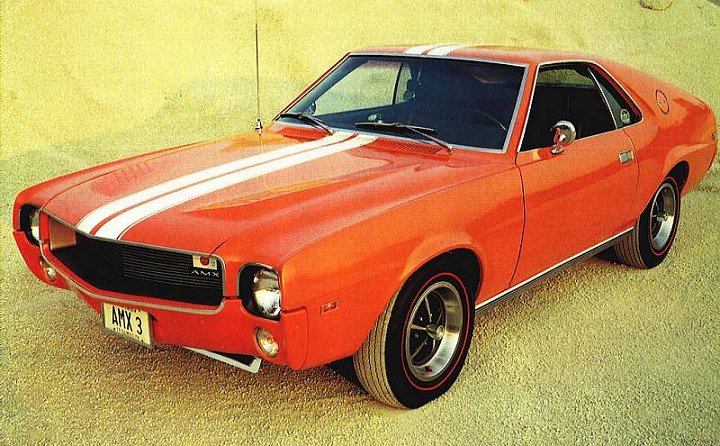The rumble of a V8 engine echoes through the streets of late 1960s America. Muscle cars dominate the automotive landscape, with Ford, Chevrolet, and Dodge battling for supremacy. Then, from an unexpected corner, American Motors Corporation throws its hat into the ring with a bold statement — the 1968 AMX.
This wasn’t just another muscle car joining the horsepower wars. AMC crafted something entirely different: a compact, aggressive machine that broke free from the traditional muscle car template. The AMX emerged as a unique blend of European sports car sensibilities and raw American power.
Breaking the Mold: AMC’s Bold Vision
American Motors Corporation faced a critical decision in the late 1960s. The muscle car market was booming, but entering it meant competing with industry giants. AMC chose to innovate rather than imitate, developing a shorter, more agile platform that would distinguish the AMX from its larger competitors.
The development team focused on creating a true driver’s car. They shortened the wheelbase to 97 inches, making the AMX more nimble than traditional muscle cars. This decision raised eyebrows among industry veterans.
“The AMX represented a fresh approach to the muscle car formula. While others were building bigger cars with bigger engines, AMC created something more precise, more focused.” — Robert Parker, Former Road & Track Editor (1968)
Engineering teams worked overtime to ensure the shortened chassis maintained structural rigidity while accommodating powerful V8 engines. The result was a car that handled more like a European sports car than a traditional American muscle car.
This unique approach earned both praise and skepticism from the automotive press. Some celebrated its innovative design, while others questioned whether the market was ready for such a departure from the muscle car norm.
Power and Performance
Fact!
The AMX's 390 V8 engine was hand-assembled by dedicated teams at AMC's Kenosha plant, with each engine builder signing their work — a practice more common among exotic European manufacturers than American muscle car makers.
The heart of the AMX was its range of V8 engines, crowned by the mighty 390 cubic inch (6.4-liter) powerplant. This flagship engine delivered 315 horsepower and an impressive 576 Nm of torque, pushing the lightweight AMX from 0-60 mph in approximately 7 seconds.
Engine options included:
- 290 cubic inch (4.8L) V8 with 4-speed manual;
- 343 cubic inch (5.6L) V8 with Shift-Command automatic;
- 390 cubic inch (6.4L) V8 with choice of transmissions.
The combination of compact size and powerful engines created a unique performance envelope. The AMX could sprint through quarter-mile runs while remaining composed in corners — a rare trait among American performance cars of the era.
Important!
The AMX achieved several speed records at Bonneville Salt Flats in 1968, including a flying mile at over 130 mph — remarkable for a car in its price class.
Design and Innovation
The AMX’s design broke conventional muscle car rules. Its shortened wheelbase and fastback profile created a distinctive silhouette that stood out in a crowd of traditional long-hood muscle cars. The design team, led by Richard Teague, focused on aerodynamic efficiency when most competitors prioritized intimidating looks.
“We weren’t trying to build another GTO or Mustang clone. The AMX was designed to be its own thing — a sports car with muscle car power.” — James Thompson, Former AMC Designer
Interior ergonomics reflected European influences, with a driver-focused cockpit and comprehensive instrumentation. The AMX offered a level of sophistication that contrasted with the spartan interiors common in muscle cars of the era.
Premium materials and attention to detail demonstrated AMC’s commitment to quality. The automaker’s smaller size allowed for more hands-on assembly and quality control than mass-produced competitors.
Legacy and Collectibility
Today, the 1968 AMX stands as a testament to American Motors’ innovative spirit. Its unique combination of compact dimensions and powerful performance has earned it a special place in automotive history. Collectors particularly prize examples with the 390 engine and four-speed manual transmission.
Notice!
Original 1968 AMX models with documented racing history or special order options can command prices exceeding $100,000 at specialized auctions.
The AMX’s relative rarity — just over 6,000 units produced in 1968 — adds to its collector appeal. Surviving examples, especially those with original powertrains, represent an increasingly valuable investment in automotive history.
The car’s influence extends beyond its production numbers. It demonstrated that American performance cars could successfully incorporate European design elements, paving the way for future generations of American sports cars.
A Rebel’s Legacy Lives On
The 1968 AMX represents more than just another entry in the muscle car era. It embodies the spirit of innovation that can emerge when a smaller company dares to challenge established conventions.
While the Big Three dominated headlines, AMC created something truly special — a car that combined muscle car power with sports car handling in a package that still turns heads today.
Pros & Cons
| Advantages | Disadvantages |
|---|---|
| Exceptional power-to-weight ratio due to compact size | Limited production means parts can be hard to find |
| Unique styling sets it apart from other muscle cars | Smaller dealer network meant less support when new |
| Superior handling compared to contemporary muscle cars | Some interior materials haven’t aged well |
| Documented racing heritage adds collector value | Restoration costs can be higher than for more common muscle cars |
| Rarity makes it a standout at car shows | Limited passenger space compared to other muscle cars |
The AMC AMX 1968 stands as a bold statement from an underdog manufacturer. While it may not have achieved the commercial success of its competitors, it succeeded in creating something truly unique — a American muscle car with European sports car sensibilities. Today’s collectors recognize its significance, making it a increasingly valued piece of automotive history. Its legacy lives on as a reminder that innovation often comes from unexpected places, and that sometimes the most interesting cars are born when companies dare to break the mold.

